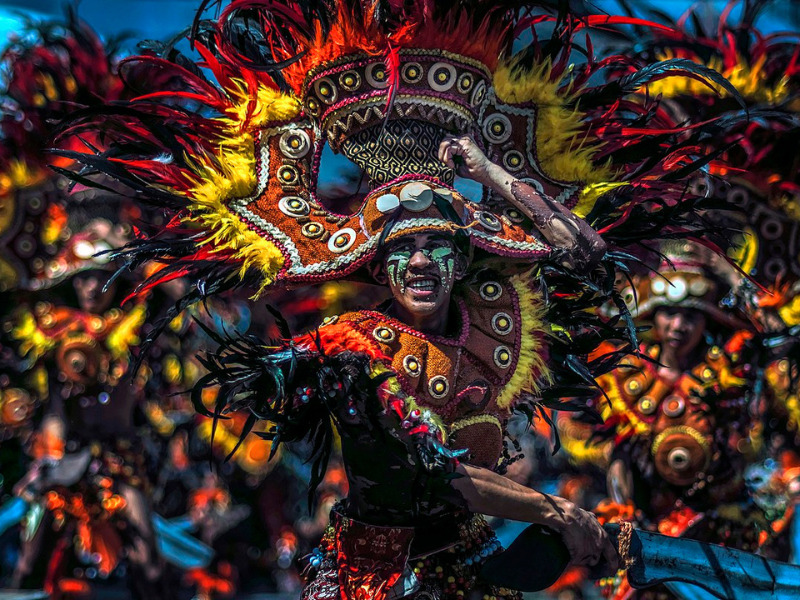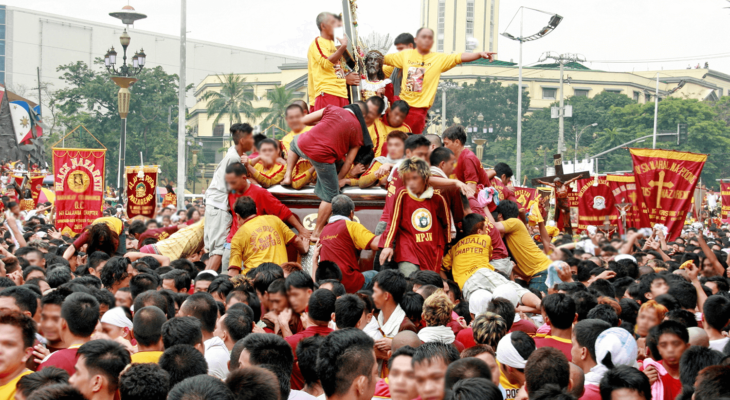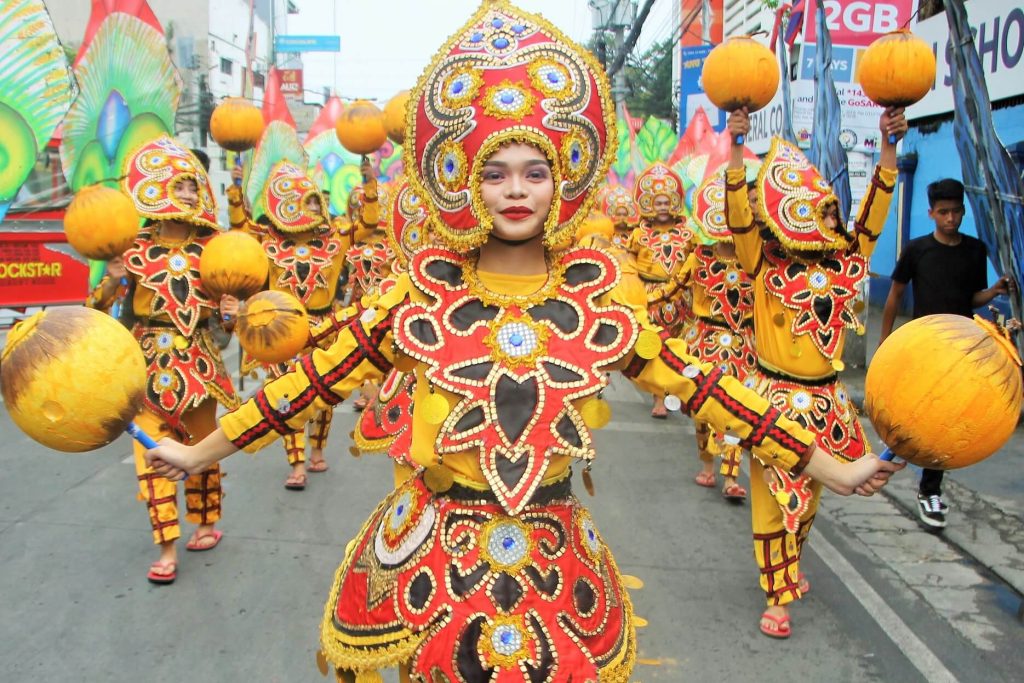Image Source: DOT-OPAA : Colourful costumes of Sinulog Festival, Philippines | Regent Holidays | Why the Sinulog Festival Should Be on Every Traveller’s Bucket List | https://www.regent-holidays.co.uk/blog/why-the-sinulog-festival-should-be-on-every-travellers-bucket-list/
The Philippines is a country that embraces its cultural heritage, and there’s no better way to experience its rich traditions than by attending its festivals. These lively events are celebrated with passion, featuring colorful parades, lively dances, street performances, and the best of Filipino cuisine. Angono, known as the ‘Art Capital of the Philippines,’ stands out for its rich cultural heritage and vibrant artistic expressions, particularly showcased through the Higantes Festival. January is particularly a great month for festival-goers, with several exciting cultural events taking place. Let’s explore the top festivals happening in January 2025 that showcase the best of Filipino culture.
Introduction to Filipino Festivals
The Philippines is a country known for its vibrant culture and rich heritage, and one of the best ways to experience this is through its numerous festivals. With over 42,000 known major and minor festivals, the Philippines is often referred to as the “Capital of the World’s Festivities.” These festivals are a testament to the country’s history, culture, and traditions, and are a great way to experience the Filipino spirit. From the Sinulog Festival in Cebu City to the Dinagyang Festival in Iloilo City, each festival has its own unique charm and attractions.
Sinulog Festival (Cebu City)
History and Significance
Sinulog Festival is one of the most iconic festivals in the Philippines, celebrated in Cebu Province, known for its vibrant culture and numerous attractions. It takes place every January in Cebu City and is a celebration of the Santo Niño (Child Jesus), honoring the Christian faith brought by Spanish colonization. The festival’s name, “Sinulog,” comes from the Cebuano word “sulog,” which refers to the forward-backward dance movement performed during the celebration.
Activities to Expect
Expect to see grand parades, where locals and tourists alike take part in the Sinulog dance—a rhythmic, circular motion symbolizing the flow of water. The event features beautifully adorned floats, traditional dances, and vibrant costumes. The dance ritual is significant in celebrating the Filipino people’s transition from paganism to Christianity. Alongside the procession, there are also religious services, street parties, concerts, and various competitions. The Sinulog Festival is a grand festival with vibrant celebrations that include parties, concerts, and parades.
Best Time to Visit
The festival culminates on the third Sunday of January, but the celebration typically lasts for a week, with events and preparations beginning a few days before. For a truly immersive experience, plan your trip to Cebu a few days before the grand parade to witness the full festivities. The broader Sinulog celebration includes various festivals, emphasizing its cultural and historical importance.
Ati-Atihan Festival (Kalibo, Aklan)
Cultural Roots and Evolution
Ati-Atihan is often considered the “Mother of All Philippine Festivals.” Held in Kalibo, Aklan, it has its roots in the indigenous Ati people, who are said to have been visited by the Malay settlers. The festival celebrates the Sto. Niño (Child Jesus) and features the iconic “pintados” or painted faces. The word “Ati-Atihan” translates to “make believe Ati,” referring to the custom of painting faces with soot to mimic the Ati tribe.
What Makes It Unique
One of the most distinct aspects of the Ati-Atihan Festival is the colorful face painting and costumes. The streets are alive with revelers dancing to the rhythm of drumbeats, creating an energetic and immersive experience. The festival is both a religious and cultural event, offering a unique blend of indigenous traditions and Christian beliefs.
Celebratory Highlights
Apart from the street dancing and the procession, Ati-Atihan is also known for its “Sadsad” or group dances. Participants often join in spontaneous dance-offs, creating a contagious, celebratory atmosphere. The festival culminates on the third Sunday of January with a grand parade.
When to Visit
Ati-Atihan takes place every January in Kalibo, with the main activities usually occurring from the 17th to the 19th. Arriving early ensures you can enjoy all the pre-festival activities.

Source: Wikipedia
Panagbenga Festival (Baguio City)
A Floral Extravaganza
Although primarily held in February, the preparations for the Panagbenga Festival begin as early as January. Known as the “Flower Festival,” Panagbenga takes place in Baguio City, a highland paradise famous for its cooler climate and vibrant flowers. The festival celebrates the beauty of Baguio’s flora and features spectacular flower floats, street dancing, and other festivities.
Key Events of Panagbenga
The highlight of the festival is the grand float parade, where elaborately decorated floats made of fresh flowers traverse the streets of Baguio. In addition to the parade, you’ll find flower exhibits, street dancing performances, and a wide variety of cultural activities that showcase the artistry and creativity of the locals.
Why You Shouldn’t Miss It
If you love flowers and nature, this is the perfect festival for you. The city transforms into a stunning, fragrant landscape, and you’ll get to witness the ingenuity of the artists who craft these breathtaking floral floats.
Feast of the Black Nazarene (Manila)
Religious Significance
January in Manila sees the grand celebration of the Feast of the Black Nazarene, one of the most important religious events in the Philippines. The Black Nazarene is a life-sized statue of Jesus Christ, believed by many to have miraculous powers. Every year, millions of devotees gather to celebrate this feast with fervor, faith, and devotion.
The Procession and Its Meaning
The highlight of the Feast of the Black Nazarene is the “Traslacion,” a massive procession where the statue is carried through the streets of Quiapo by thousands of devotees, many of whom walk barefoot as a sign of penance. The procession is both an expression of faith and a testament to the devotion of the Filipino people.
How to Participate
If you’re visiting during this time, it’s important to be prepared for large crowds. It’s a truly humbling experience to witness the devotion and faith of the participants, but it can be overwhelming, so plan accordingly.

Image Source: Tony Magdaraog / Shutterstock.com
Dinagyang Festival (Iloilo City)
Origin and MeaningThe Iloilo Dinagyang Festival in Iloilo City is a colorful and spirited celebration that commemorates the arrival of the Malay settlers in Panay Island and the conversion of the indigenous Ati people to Christianity. The festival is known for its intense street dancing, drumming, and elaborate costumes, and it has a strong presence on social media platforms like Facebook, fostering community interaction and promotion.
Fun Activities During DinagyangDinagyang is known for its spectacular street dances, where dancers perform to the beat of drums and wear colorful, feathered costumes. The grand street dancing competition is the highlight, but the entire city becomes a celebration zone, with food stalls, musical performances, and cultural exhibits to explore. The festival is celebrated on the fourth Sunday of January, adding to its vibrant and festive atmosphere.
Kuyamis Festival
Celebrating Misamis Oriental’s Rich Heritage
The Kuyamis Festival is an annual celebration held in the province of Misamis Oriental, Philippines. Known for its vibrant activities and cultural significance, the festival has gained popularity for showcasing the rich traditions, natural beauty, and thriving coconut industry of the region. Held every January, Kuyamis brings together locals and tourists to revel in the unique charm of Misamis Oriental.
Kuyamis Street Dancing Competition
One of the main attractions of the festival is the street dancing competition. Participants from different municipalities dress in colorful costumes inspired by coconuts and other local elements. They perform energetic and creative dances to the rhythm of traditional music, showcasing the artistic spirit of the province.
Why Visit the Kuyamis Festival?
The Kuyamis Festival is more than just a celebration; it’s an immersive experience into the culture, history, and natural beauty of Misamis Oriental. Whether you’re a foodie looking to savor coconut-inspired delicacies, a history buff eager to learn about the province’s past, or an adventurer seeking outdoor thrills, the festival has something for everyone.

Image Source: https://opolmisor.gov.ph/ | Opol Miduyog sa 6th Kuyamis Festival | https://opolmisor.gov.ph/2019/01/11/opol-miduyog-sa-6th-kuyamis-festival/
Diyandi Festival
A Vibrant Celebration of Devotion and Culture
The Diyandi Festival, held annually in Iligan City, Philippines, is a month-long celebration of culture, history, and faith. Known for its energetic street dances, colorful parades, and religious devotion, the festival honors St. Michael the Archangel, the city’s patron saint. “Diyandi” comes from the Cebuano word meaning “to celebrate,” and the festival is a true reflection of the lively and diverse traditions of Iligan.
Pagkanaug and Procession of St. Michael
The Pagkanaug is a revered religious ritual where the image of St. Michael is taken from its altar and paraded through the city. This event marks the start of the festivities and reflects the deep faith of the Iliganons. The procession is accompanied by prayers, hymns, and the lighting of candles.
Religious Significance
St. Michael the Archangel is deeply revered in Iligan for his role as a protector and defender. Religious activities, such as novenas, Holy Masses, and the grand procession on September 29, underline the festival’s spiritual essence. Pilgrims from nearby provinces often travel to Iligan to join in the celebrations, making it a time of reflection, prayer, and unity.
Festival Experiences
Attending a festival in the Philippines is an experience like no other. The energy is electric, the colors are vibrant, and the music is infectious. Whether you’re watching the Sinulog Grand Parade in Cebu City or dancing in the streets during the Masskara Festival in Bacolod City, you’ll be surrounded by the sights and sounds of Filipino culture. Many festivals also offer a range of activities, from street fairs to cultural performances, so there’s always something to do. And with the warm hospitality of the Filipino people, you’ll feel right at home.
Cultural Significance of the Festivals
The festivals in the Philippines are more than just a celebration – they’re a way of life. Many festivals are rooted in Christianity, dating back to the Spanish colonial period, and are a way of honoring the local Roman Catholic patron saint. Others are a celebration of the country’s rich cultural heritage, showcasing traditional dances, music, and costumes. The festivals also play an important role in promoting community products and celebrating a bountiful harvest. Whether you’re interested in history, culture, or just want to experience the Filipino spirit, the festivals are a great way to do so.
Practical Tips for Festival-Goers
If you’re planning to attend a festival in the Philippines, here are a few practical tips to keep in mind. First, plan ahead and book your accommodations and tour packages in advance, especially during peak festival season. Second, wear comfortable clothes and footwear, as you’ll likely be doing a lot of walking and dancing. Third, stay hydrated and bring sunblock, as the sun can be strong during the day. Finally, be patient and enjoy the festive atmosphere – the festivals can get crowded, but the energy is always electric.
Getting There and Getting Around
Getting to the Philippines is relatively easy, with many international flights arriving in Manila, the capital city. From there, you can take domestic flights or buses to get to the different festival locations. Cebu City, for example, is a major hub for the Sinulog Festival, and is easily accessible by plane or bus. Iloilo City, on the other hand, is a bit further away, but is still accessible by plane or bus. Once you arrive at the festival location, getting around is relatively easy, with many taxis and jeepneys available. You can also walk or take a tricycle to get around, depending on the location.
Conclusion
Filipino festivals are a reflection of the country’s vibrant culture, blending faith, history, and community spirit in colorful, energetic celebrations. January 2025 brings with it some of the best festivals to attend, each offering a unique experience. Whether you’re drawn to the religious devotion of the Feast of the Black Nazarene, the street dances of Sinulog and Dinagyang, or the vibrant floats of Panagbenga, there’s something for everyone to enjoy. These festivals are not just events—they are an invitation to dive deep into the heart of Filipino culture and tradition.



